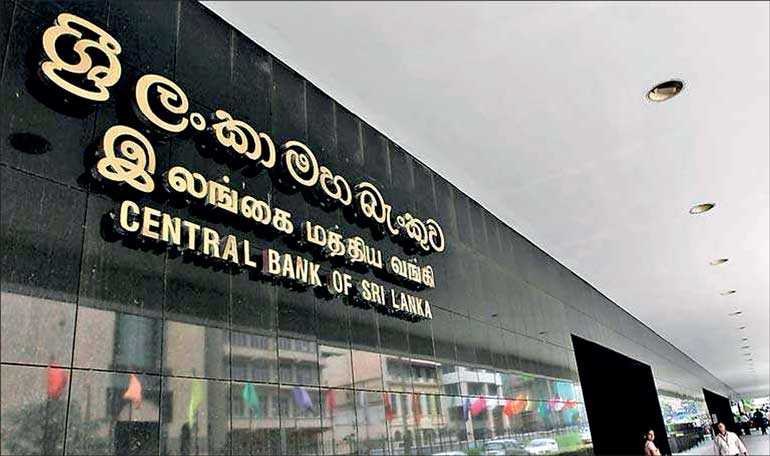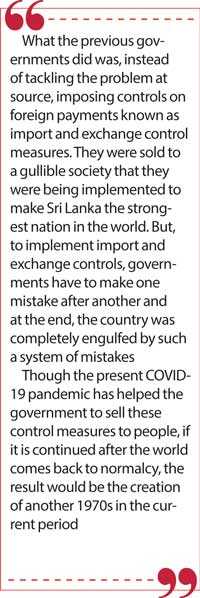Monday Dec 29, 2025
Monday Dec 29, 2025
Monday, 1 June 2020 00:30 - - {{hitsCtrl.values.hits}}

Criticising the Central Bank’s new monetary policy framework
In the past few years, specifically in the last two weeks, there has been a number of contributions made by some independent economists expressing reservations about the Central Bank’s new monetary  policy framework known as ‘flexible inflation targeting’. Some of these critics have come from among mainstream economists who normally subscribe to the accepted economic wisdom relating to money and monetary policy. However, among them, a few have distanced themselves from the mainstream economists calling themselves as products of alternative economics schools and been critical of the new policy framework.
policy framework known as ‘flexible inflation targeting’. Some of these critics have come from among mainstream economists who normally subscribe to the accepted economic wisdom relating to money and monetary policy. However, among them, a few have distanced themselves from the mainstream economists calling themselves as products of alternative economics schools and been critical of the new policy framework.
The first category has branded flexible inflation targeting as impractical. The second category has gone beyond this criticism and labelled it a monstrous policy coming from IMF, one of the three institutions making up of now dead Washington Consensus that worship, according to them, neoliberal economic policies. Hence, their objection to flexible inflation targeting is an extension of their deep-rooted objection to IMF, Washington Consensus and neoliberal economic policies.
Criticisms should be welcome by the Central Bank
The Central Bank should welcome such criticisms of its policies by independent economists for two reasons. One is that it causes to generate a public debate over the Bank’s policies, a must in an accountable democracy that upholds the virtues of good governance principles. The other is that it gives an opportunity for the Bank to ascertain the shortcomings of its communication strategies and make amends for same. Hence, in my view, the Bank should promote such public debates, both within and outside the Bank, as much as possible.
The guiding principle is that, Homo sapiens, Man the Wise, is by nature argumentative and that has to be accommodated in any social intercourse he wishes to have. Hence, those arguments, especially the dissenting ones, should be resolved in platforms in which the opponent in a debate, as laid down by Emperor Asoka in one of his rock inscriptions, should be treated with honour and respect in every way possible.
Flexible inflation targeting was a process
The Central Bank’s journey toward inflation targeting was started in 2004 as a part of its modernisation program. But, due to a lack of any support from the government in power at that time, the Central Bank could not attain much progress in the project. It was virtually an abandoned project until it was rediscovered in 2016 by IMF when it rescued Sri Lanka by offering an extended fund facility to the country. To obtain the facility, the Sri Lanka government had pledged to IMF that it would introduce both a flexible exchange rate regime and an inflation targeting framework over the next three-year period.
The Central Bank too in a special box article in its Annual Report for 2016, released in April 2017, had emphasised the need for introducing inflation targeting as the country’s monetary policy framework. The previous government, in its medium-term economic policy strategy contained in Vision 2025 released to public in August 2017 and the economic policy statement delivered in Parliament in October had reiterated its commitment to support the Central Bank to go for flexible inflation targeting.
The detailed outline of the Bank’s flexible inflation targeting was presented by its Senior Deputy Governor Dr. Nandalal Weerasinghe in a memorial oration delivered in Colombo later in the year. A review of this memorial oration can be found at http://www.ft.lk/columns/Central-Bank-s-move-to-flexible-inflation-targeting-Wide-public-education-is-needed/4-644096.
In this review, while endorsing the Bank’s move to flexible inflation targeting, it was suggested that wide public education is needed in order to disabuse the minds of the people about the new policy framework. This suggestion has become prophetic today, given the adverse criticisms levelled against the Central Bank by some of the mainstream economists in the country.
Central banks are to manage aggregate demand to avoid both inflation and deflation
The current criticism against the flexible inflation targeting has arisen from a misunderstanding of what a central bank is for and what is meant by its monetary policy framework.
Central banks throughout the world have been created by respective societies only for one purpose: That is to maintain the value of money it produces by managing the total demand in the economy, known as the aggregate demand for goods and services, to be equal to the total supply of goods and services, known as the aggregate supply. If the money stock suddenly increases and people do not want to keep that money at homes in the form of money, it would cause them to spend that money to buy goods and services, on one side, and invest in bonds leading to a decline in the interest rates in the system, on the other.
When money is spent on goods and services, it would directly increase the aggregate demand. If it is spent for buying bonds, the resultant decline in the interest rates will force people to increase consumption as well as investment. Whatever the course of action they would take, it would increase the aggregate demand and through it, a general increase in the price level causing a reduction of the real value of the wealth they are holding.
This is what we want to avoid and we, as members of society, have created central banks to deliver this much cherished price stability to us. We do not want prices to go up or go down. An increase in the prices will bring forth inflation reducing the real value of our wealth. A decline in prices will cause deflation reducing the profits of the producers. If this deflationary trend continues, the producers would become bankrupt causing a production cut and massive unemployment. Central banks are expected by us to avoid both these extremes by managing the aggregate demand properly. To attain that objective, the operating system they use is called monetary policy. That is why monetary policies are also known as demand management policies.
Monetary policy is only the operating system
Thus, the job of a central bank is to manage aggregate demand to avoid both inflation and deflation. The operating system it would use to accomplish this job is called the monetary policy. Whenever the  central banks would find that the particular operating system is not effective, they would seek to improve it or replace it with a completely new operating system. This can be understood by considering an analogy. Take for example, a computer and its operating system. The job of the computer is to process the data that is fed to it and produce the end results which the user of the computer desires. For instance, if the user desires to draw a graph by using a particular set of data, the computer alone cannot do it without a supportive operation system. There are many such operating systems like Ubuntu, MS Office or iOS and the user is free to change from one system to another if the existing system is not effective. This analogy tells us that one cannot reject the operating system without rejecting the computer as well.
central banks would find that the particular operating system is not effective, they would seek to improve it or replace it with a completely new operating system. This can be understood by considering an analogy. Take for example, a computer and its operating system. The job of the computer is to process the data that is fed to it and produce the end results which the user of the computer desires. For instance, if the user desires to draw a graph by using a particular set of data, the computer alone cannot do it without a supportive operation system. There are many such operating systems like Ubuntu, MS Office or iOS and the user is free to change from one system to another if the existing system is not effective. This analogy tells us that one cannot reject the operating system without rejecting the computer as well.
Central Bank has liberally changed the operating system in the past
The Central Bank of Sri Lanka in the past 70-year period has changed its operating system on a number of occasions when it had found that particular operating system it had been using was not effective in delivering its main job, that is to avoid both inflation and deflation. Till about early 1980s, the Bank had used a particular operating system focussing on the control of what has been defined as the narrow money supply consisting of the currencies and demand deposits held by the public. Since this happened to be the knowledge base which economists had about money supply in late 1940s, even the Monetary Law Act under which the Bank has been setup had legally defined the money supply to be so.
Broadening money supply and use of controlling Monetary Base
But by early 1980s, Governor Warnasena Rasaputra had realised that that particular definition was inadequate and instructed the Bank’s officials to come up with a new definition of money supply. Under Rasaputra’s direction, two improvements were made to the operating system. One was to broaden the operational money supply as broad money supply consisting of time and savings deposits held by the public in commercial banks, in addition to the currencies and demand deposits which had been covered under the narrow money definition.
The other had two sides: first to focus on controlling what is known as seed money created by the Central Bank through its operation. The second was to connect these money goals to a National Credit Plan. If the Bank can control this seed money, also known as Reserve Money, Base Money, Base, Monetary Base or High-Powered Money, it could control the final level of money supply in whatever way it is defined.
The National Credit Plan allowed the Bank to allocate that final level of money that does not create either inflation or deflation between the government and the private sector and among the private sector borrowers, for what the Bank has identified as priority sectors. In a few years’ time, the Bank realised that the National Credit Plan does not work and therefore it was abandoned.
Realising the need for inflation targeting
However, the Monetary Base Control as the main operating system of the Bank was continued with minor improvements till early 2000s. In about this time, the Bank realised that the operating system involving the control of the Monetary Base was not effective and there was a need for going for a new operating system. The identified new operating system was to target inflation directly known as inflation targeting. This work continued under the direction of Governor A.S. Jayawardena when the Bank had embarked on a modernisation project. However, he could not hold onto that position until its final outcome was produced.
That was done under Governor Indrajit Coomaraswamy in about 2017. But there was a slight modification to inflation targeting by further qualifying it as flexible inflation targeting. The flexible part allowed the Central Bank to do away with inflation targeting if the economy was hit by deflation resulting in a decline in the total output or an increase in unemployment. In other words, the Bank has awarded itself the freedom to change the direction of the monetary policy if it is confronted with an adverse situation like the one it experiences today as a fallout of the ongoing COVID-19 pandemic.
Imposing costly import and exchange controls
What this means is that the critics of the flexible inflation targeting have not properly understood the purpose of a central bank and the difference between a central bank and its operating system. When they have criticised the operating system calling for its rejection, they invariably call for the rejection of the central bank that operates the operating system involved.
Once both are rejected, society does not have a mechanism to control the production of money over and above the needs of the economy. That money would be spent on goods and services and to the extent those goods and services are procured from external sources, it leads to an imbalance in foreign receipts and foreign payments. The resultant deficit leads to a depreciation of the exchange rate as it has happened throughout the post-independence history of Sri Lanka.
Making one mistake after another
What the previous governments did was, instead of tackling the problem at source, imposing controls on foreign payments known as import and exchange control measures. They were sold to a gullible society that they were being implemented to make Sri Lanka the strongest nation in the world. But, to implement import and exchange controls, governments have to make one mistake after another and at the end, the country was completely engulfed by such a system of mistakes. I have discussed the repercussions of such mistakes in a previous article in this series available at: http://www.ft.lk/columns/Post-COVID-19-reconstruction-Monkeys-may-be-smarter-when-following-forefathers/4-698977.
Return to 1970s
The gist of the argument was that while these controls failed to deliver the intended results, they also led to economy-wide inefficiencies worsening the economic conditions of the country. Knowingly or unknowingly, the present government too has resorted to these control measures banning the importation of what it has classified as luxury or inessential goods altogether.
Though the present COVID-19 pandemic has helped the government to sell these control measures to people, if it is continued after the world comes back to normalcy, the result would be the creation of another 1970s in the current period.
In that scenario in 1970s, letters of credit opened by Sri Lankan banks were accepted by foreign banks if and only if they were guaranteed by third-party reputed bank. By asking importers of inessential and luxury goods to go for three to six-month credit, the government has sanctioned this third-party guarantee of the country’s payments.
In other words, the message delivered is that Sri Lanka would default its payments and therefore, it is necessary to arrange for a period letter of credit extending up to six months known as a usance letter of credit. In the current letters of credit, the bank has to make a payment immediately once it has spotted the bill, known as a sight payment, provided the exporter at the other end has satisfied all the conditions laid down in the letter of credit.
Thus, the critics of the flexible inflation targeting should realise that there is a difference between the central bank and its operating systems and rejecting the operating system would invariably lead to the rejection of the central bank as well.
(The writer, a former Deputy Governor of the Central Bank of Sri Lanka, can be reached at [email protected].)